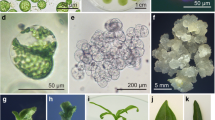Abstract
Cytological studies on leaf callus cells and regenerated potato plants suggest that it may be possible to utilize somatic chromosome doubling to obtain tetraploids from outstanding dihaploid breeding clones. The ploidy levels found in callus-derived plants were diploid, tetraploid, and octaploid, but the proportion of these was dependent on the donor genotype. L1 and L3 germ layers were studied in more than 300 plants; periclinal ploidy chimerism, an undesirable feature of colchicine doubling, was not found.
Leaf callus was more efficiently induced using NAA than 2, 4-D as an auxin source in the Murashige and Skoog medium. A high proportion of dividing cells in young calli were polyploid. The frequency of doubled and octaploid plants regenerated was significantly dependent on donor genotype. The extent of polyploidization was marginally higher after callus growth on a medium containing 2, 4-D than in a medium containing NAA. In some genotypes the chromosome numbers of regenerated plants were variable, being less than tetraploid (mixohypotetraploid). After tuber propagation, the original ploidy level was maintained although mixohypotetraploidy persisted.
In a few somatically doubled clones, male fertility was tested and found to be satisfactory with respect to seed-setting.
Similar content being viewed by others
References
Benhke M (1975) Regeneration in Gewebekulturen einiger dihaploiderSolanum tuberosum Klone. Z Pflanzenzuecht 75:262–265
Bourgin JP, Missonier C (1978) Culture de protoplasts de mésophylle deNicotania alata Link et Otto haploid. Z Pflanzenphysiol 87:55–64
Frandsen NO (1967) Chimären verschiedener Ploidiestufen aus haploiden Kartoffelklonen. Z Pflanzenzuecht 57:123–145
Gleba YY (1978) Non-chromosomal inheritance in higher plants as studies by somatic cell hybridization. In: Plant cell and tissue culture principles and applications. The fourth Annual College of Biological Science Colloquium, Ohio State University (in press)
Grünewald J, Malepszy S (1975) Beobachtungen an Antherenkallus vonHordeum vulgare L. Z Pflanzenzuecht 75:55–61
Jacobsen E (1978) Doubling dihaploid potato clones via leaf tissue culture. Z Pflanzenzuecht 80:80–82
Mix G, Wilson HM, Forougi-Wehr B (1978) The cytological status ofHordeum vulgare L. regenerated from microspore callus. Z Pflanzenzuecht 80:89–99
Murashige T, Skoog F (1962) A revised medium for rapid growth and bioassay with tobacco tissue cultures. Physiol Plant 15:473
Novak FJ, Vyskot B (1975) Karyology of callus cultures derived fromNicotiana tabacum L. haploids and ploidy of regenerants. Z Pflanzenzuecht 75:62–70
Ross RW, Dionne LA, Hougas RW (1967) Doubling the chromosome number of selectedSolanum genotypes. Eur Potato J 10:37–52
Ross H, Jacobsen E (1976) Beobachtungen an Nachkommenschaften aus Kreuzungen zwischen dihaploiden und tetraploiden Kartoffelformen; Samenzahl, Ploidiestufe sowie Spaltungsverhältnisse des Gens für extreme Resistenz gegen das X-Virus (Rxacl). Z Pflanzenzuecht 76:265–280
Sekija J, Yasuda T, Yamada Y (1977) Callus induction in tobacco, pea, rice and barley plants by auxins and their analogues. Plant Cell Physiol 18: 1155–1157
Sopory SK (1976) Development of embryoids in isolated pollen culture of dihaploidSolanum tuberosum. Z Pflanzenphysiol 84:453–457
Soropy SK, Tan BH (1979) Regeneration and cytological studies of anther and pollen calli of dihaploidSolanum tuberosum. Z Pflanzenzuecht 82:31–35
Sree Ramulu K, Devreux M, Ancora G, Laneri U (1976) Chimerism inLycopersicon peruvianum plants regenerated from in vitro culture of anthers and stem internodes. Z Pflanzenzuecht 76:299–319
Tjio JH, Levan A (1950) The use of oxychinoline in chromosome analysis. An estacion exo. Aula Deiz 2:1–64
Author information
Authors and Affiliations
Rights and permissions
About this article
Cite this article
Jacobsen, E. Polyploidization in leaf callus tissue and in regenerated plants of dihaploid potato. Plant Cell Tiss Organ Cult 1, 77–84 (1981). https://doi.org/10.1007/BF02318906
Received:
Revised:
Issue Date:
DOI: https://doi.org/10.1007/BF02318906




